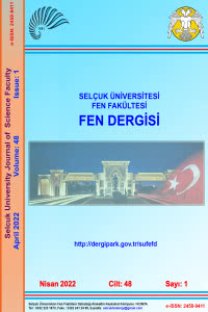A GIS BASED NEW NAVIGATION APPROACH FOR REDUCING EMERGENCY VEHICLE'S RESPONSE TIME
Acil Müdahale Araçlarının Müdahale Zamanını Azaltmak İçin Cbs Tabanlı Bir Navıgasyon Yaklaşım
___
- Ahuja, R., Orlin, K., James, B., Pallottino, S., Scutella, M. G., 2002, Dynamic Shortest Paths Minimizing Travel Times and Costs, MIT Sloan Working Paper; No. 4390-02.
- Aktas, S.G., Swalehe, M., 2016, “Dynamic Ambulance Deployment to Reduce Ambulance Response Times using Geographic Information Systems: A Case Study of Odunpazari District of Eskisehir Province, Turkey”, Procedia Environmental Sciences, Vol. 36, pp. 199 – 206.
- Altınbaş, K. H., Bilir, N., 2001, Ambulance Times of Ankara Emergency Aid and Rescue Services Ambulance System”, European Journal of Emergency Medicine, Vol. 8, pp. 43-50.
- Ateş, S., Coşkun, Z. M., Aydınoğlu, A. Ç., “Coğrafi Bilgi Sistemleri ile En Uygun Ambulans Yerlerinin Belirlenmesi”, 13. Türkiye Harita Bilimsel ve Teknik Kurultayı, Ankara, 18-22 Nisan 2011.
- Bandyopadhyay, M., Singh, V., 2016, “Development of Agent Based Model For Predicting Emergency Response Time”, Perspectives in Science, Vol. 8, pp. 138—141.
- Blackwell, T. H. Kaufman, J . S., 2001, “Response Time Effectiveness: Comparison of Response Time and Survival in an Urban Emergency Medical Services System”, Academic Emergency Management, Vol. 9, pp. 288-295.
- Brown, L.H., Whitney, C.L., Hunt, R.C., Addario, M., Hogue, T., 2000, “Do Warning Lights and Sirens Reduce Ambulance Response Times?”, Prehospital Emergency Care, Vol. 4, pp. 70–74.
- Campbell A, M., Vandenbussche D., Hermann W., 2008, “Routing for Relief Efforts”, Transportation Science, Vol. 42, pp. 127–145.
- Haghani, A., H. Hu., Q. Tian., “An Optimization Model for Real-Time Emergency Vehicle Dispatching and Routing”. In: the 82nd Annual Meeting of the Transportation Research Board, Washington, D.C., 12-16 January 2003.
- Ho, J., Casey, B., 1998, “Time Saved with Use of Emergency Warning Lights and Sirens During Response to Requests for Emergency Medical Aid in Urban Environment”, Annals of Emergency Medicine, Vol. 32 (5), pp. 585–588.
- Ho, J., Lindquist, M., 2001, “Time Saved with Use of Emergency Warning Lights and Siren While Responding to Requests for Emergency Medical Aid in A Rural Environment”, Prehospital Emergency Care, Vol. 5, pp. 159–162.
- Huang, D., Chu, X., Mao Z., 2012, “A Simulation Framework for Emergency Response of Highway Traffic Accident”, Procedia Engineering, Vol. 29, pp. 1075 - 1080.
- Kerstin P., Jan, P., Jörgen, J., Gun N., 2011, “Time Saved with High Speed Driving of Ambulances”, Accident Analysis and Prevention, Vol. 43(3), pp. 818–822.
- Kobusingye OC, Hyder AA, Bishai D, Joshipura M, Hicks ER, Mock C., 2010, Emergency Medical Services,New York: John Wiley & Sons Ltd; 2010.p.167-. 169. 17.
- Konstantinos G. Zografos., George M. Vasilakis., Ioanna M. Giannouli., 2000, “Methodological Framework for Developing Decision Support Systems (DSS) for Hazardous Materials Emergency Response Operations”, Journal of Hazardous Materials, Vol. 71 (1–3.7), pp. 503–521.
- Lam, S.S., Zhang, J., Zhang, Z. C., Oh, H. C., Overton, J., Ng, Y. Y., Ong, M. E., 2015, “Dynamic Ambulance Reallocation for The Reduction of Ambulance Response Times Using System Status Management”, The American Journal of Emergency Medicine, Vol. 33, pp. 159-166.
- Liu, H., Hall, R., 2002, W. INCISIM: User’s Manual. California Path Research Report; UCB-ITS-PWP-2000-15.
- Minciardi, R., Sacile, R., Trasforini, E., 2007, “A Decision Support System for Resource Intervention in Real-Time Emergency Management”, International Journal of Emergency Management, Vol. 4 (1), pp. 59-71.
- Mohd, S., Mohd, I., Syed, M., 2008, “Ambulance Response Time and Emergency Medical Dispatcher Program: A study in Kelantan, MALAYSIA”, Southeast Asian Journal of Tropical Medicine and Public, Vol 39 (6).
- Narad, R. A., Iesbock, K. R., 1999, “Regulation of Ambulance Response Time in California”, Prehospital Emergency Care, Vol. 3, pp. 131-135.
- Ong M, E., Ng FS., Overton J., Yap S., Andresen D., Yong DK., Lim SH., Anantharaman V., 2009, “Geographic Time Distribution of Ambulance Calls in Singapore: Utility of Geographic Information System in Ambulance Deployment”, Annals Academy of Medicine, Vol. 38, pp.91-94.
- Ozbay, K., Bartin, B., 2003, “Incident Management Simulation”, Simulation, Vol. 79(2), pp. 69-82.
- Paraskevi S. Georgiadoua, Ioannis A. Papazoglou, Chris T. Kiranoudisa, Nikolaos C. Markatosa., 2010, “Multi-Objective Evolutionary Emergency Response Optimization for Major Accidents”, Journal of Hazardous Materials, Vol. 178, pp. 792–803.
- Peter S, J., Hall, G. B., 1999, “Assessment of Ambulance Response Performance Using A Geographic Information System”, Social Science & Medicine, Vol. 49, pp. 1551-1556.
- Stefan, R., Walter,.G., 2014, “A Math-Heuristic for The Warehouse Location–Routing Problem in Disaster Relief”, Computers & Operations Research, Vol. 42, pp. 25 – 39.
- Yoon, S,W., Velasquez, J.D., Partridge, B.K., Nof., S,Y., 2008, “Transportation Security Decision Support System for Emergency Response: A Training Prototype”, Decision Support Systems, Vol. 46, pp. 139–148.
- Zhang, Z., He, Q., Gou, J., Li,X., 2016, “Performance Measure for Reliable Travel Time of Emergency Vehicles, Transportation Research Part C, Vol. 65, pp. 97–110.
- Ziliaskopoulos, A., H. Mahmassani., 1993, “Time Dependent, Shortest-Path Algorithm for Real-Time Intelligent Vehicle Highway System Applications”, Transportation Research Record, 1480; pp. 94- 100
- Lin, S.H., Lai, C.L., 2000, “Kinetic Characteristic of Textile Wastewater Ozonation in Fluidized and Fixed Activated Carbon Belts”, Water Research, Vol. 34, pp. 763-772.
- ISSN: 2147-9364
- Yayın Aralığı: 2
- Başlangıç: 2013
- Yayıncı: Selçuk Üniversitesi Mühendislik Fakültesi
EAL ESTATE VALUATION IN URBAN REGENERATION APPLICATION; CASE STUDY OF KONYA
COMPARISON OF ASTER AND SRTM DIGITAL ELEVATION MODELS AT ONE -ARC-SECOND RESOLUTION OVER TURKEY
İBRAHİM ÖZTUĞ BİLDİRİCİ, Ramazan Alpay Abbak
RECOVERY OF FORMIC ACID BY REACTIVE EXTRACTION USING AN ENVIRONMENTALLYFRIENDLY SOLVENT
OBJE YÜZEY EĞİMLERİNİN YERSEL LAZER TARAYICILARIN KONUM DOĞRULUĞUNA ETKİLERİ
AYDAN YAMAN, HACI MURAT YILMAZ, MÜGE AĞCA YILDIRIM
OSMAN ORHAN, MURAT YAKAR, OSMAN SAMİ KIRTILOĞLU
A GIS BASED NEW NAVIGATION APPROACH FOR REDUCING EMERGENCY VEHICLE'S RESPONSE TIME
HALİL AKINCI, AYŞE YAVUZ ÖZALP, MEHMET ÖZALP
UÇUCU KÜL İÇEREN YÜKSEK PERFORMANSLI GÜÇLENDİRME HARCINDA NANO SİLİKATIN ETKİSİ
